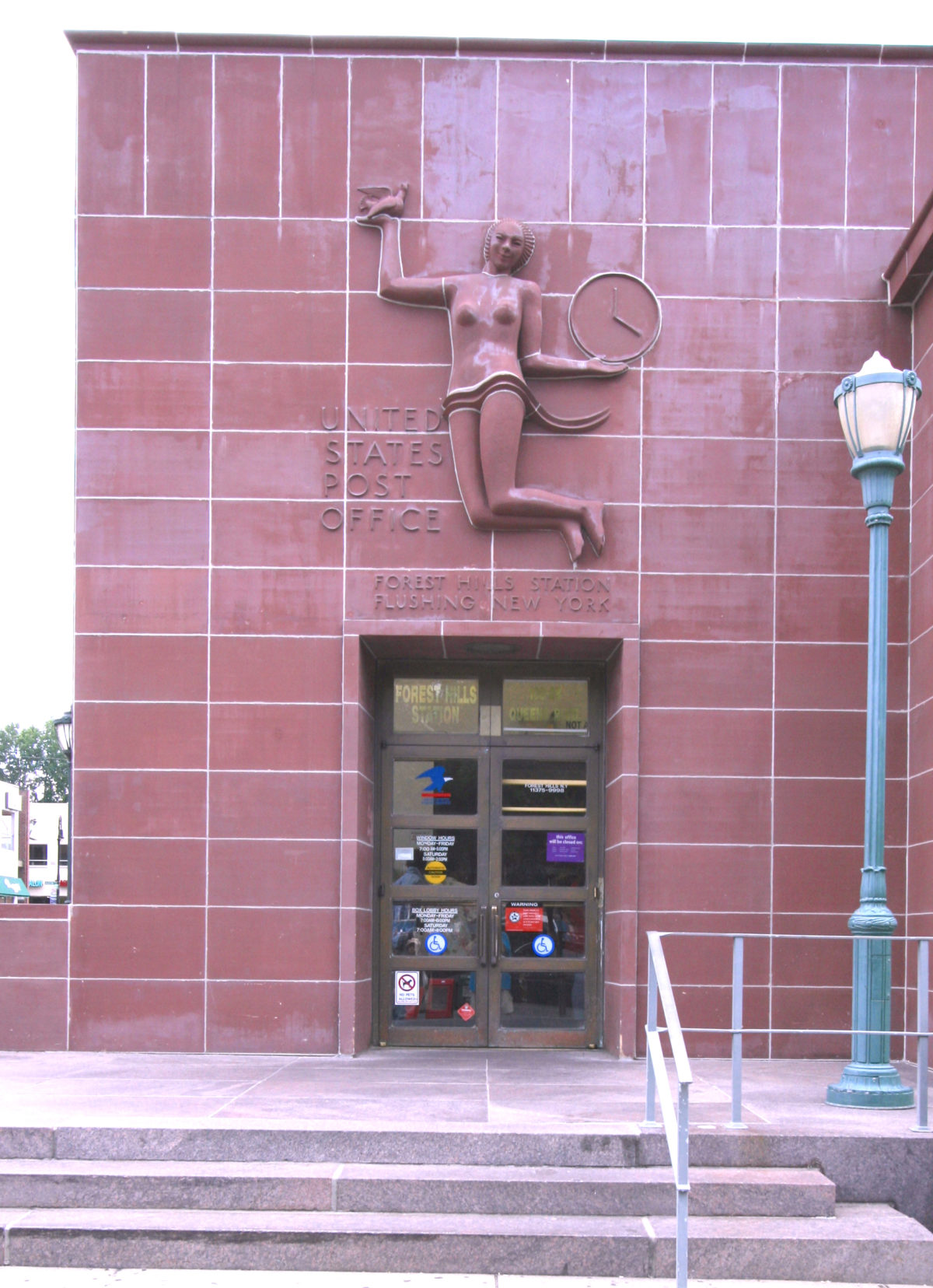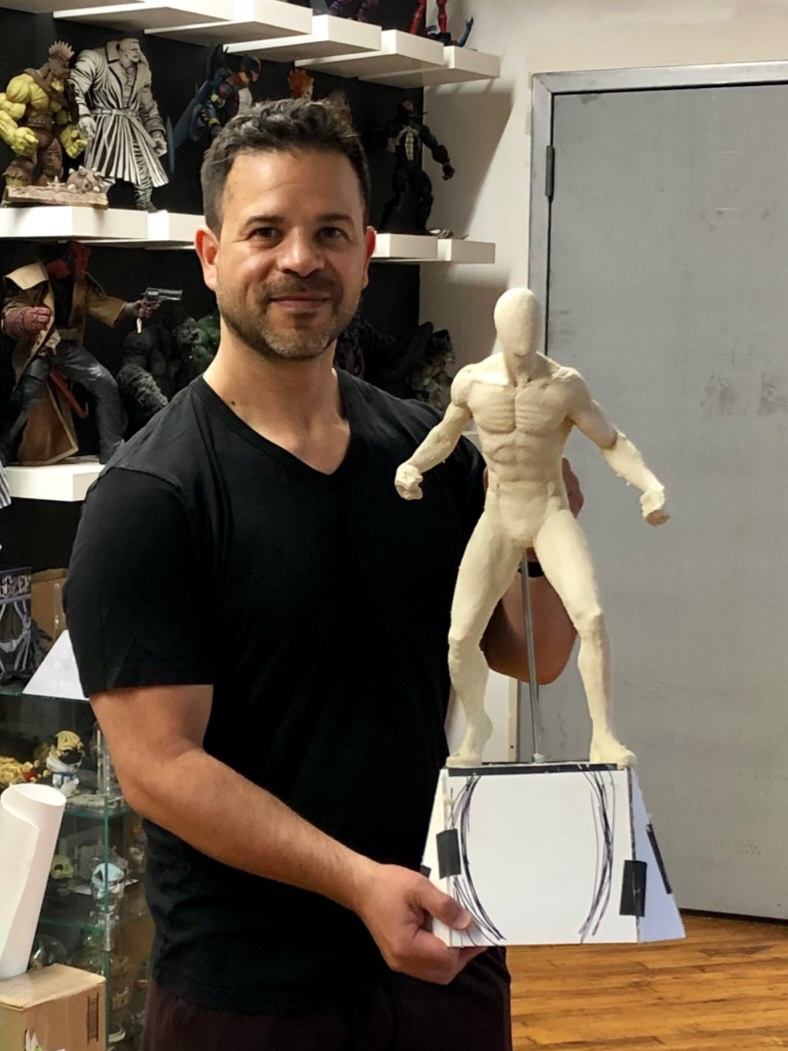Perlman: An Evolution of Local Sculptures
By Michael Perlman
Forest Hills was named in 1906, whereas Rego Park was named in 1923. For the past 116 years, there have been several freestanding sculptures, while fewer have been affixed to facades. Sculptures are few and far between, but local works exhibit fine quality and history. Above all, public art is a gift to the masses that bonds the generations. Now’s the time to discover a timeline of some of the most notable outdoor sculptures.

Fountain of Piping Pan
Fountain of Piping Pan: Sometimes a sculpture vanishes without a trace, but decades later a vision surfaces to have it replicated. This was a focal point of Olivia Park bounded by Markwood Road and Deepdene Road in Forest Hills Gardens. This environmentally beneficial feature consisted of a young male cherub playing a pipe that overlooked a bird fountain alongside the right-hand pathway as residents would walk from Markwood Road. In 1915, The Sun stated, “The presiding genius of the fountain is a small nude boy in plaster playing a pipe and the water tumbles over the stones at his feet down into a miniature lake, where the birds may disport themselves as in one of nature’s own sylvan retreats.” In response to The Bird Club of Long Island which formed that summer to safeguard birdlife, the publication stated, “From Brooklyn to Montauk Point, branch clubs are being formed, bird refuges and sanctuaries are being created, and other steps are being taken to make the bird population multiply, and the insect horde decrease.” The membership numbered 300 and spanned 40 communities.
On July 4, 1915, with a local chapter of the Audubon Society on-site, the bird fountain was unveiled. It was designed by Underwood Road resident Beatrix Forbes-Robinson Hale (later Women’s Suffrage Club of Forest Hills president) and presented by the Russell Sage Homes Company in dedication to Margaret Olivia Slocum Sage, who was praised for her passion for birds. She purchased Marsh Island to transform it into a bird sanctuary. Part of her acclaim was her establishment of the Russell Sage Foundation, which sought to improve the social and living conditions in the U.S. Olivia Park was named in her honor, and her vision was realized as it served as a natural amphitheater due to its sloping topography and acoustics.

WWI Soldiers and Sailors Memorial
WWI Soldiers & Sailors Memorial: On Flagpole Green, originally “Village Green,” in Forest Hills Gardens stands an ornate Neo-Classical pink granite and green and gold bronze monument, which honors 102 residents, and was dedicated in 1920. It was designed by renowned American sculptor Adolph Alexander Weinman (1870 – 1952), who lived nearby at 236 Greenway South and operated a studio at 234 Greenway South. The memorial reads, “Erected by the citizens of Forest Hills in recognition of the patriotic spirit and loyal devotion of the men of this community who served in the Military Forces of The United States in The Great War.” The design represents “The Call to Arms” above the names on the tablet including Dr. Joseph MacDonald, Gerald MacDonald, Henry MacDonald, George C. Meyer who served as president of Cord Meyer, and David and Howard Springsteen of the community’s farming family when Forest Hills was known as Whitepot.

Remsen Cemetery Two Doughboys
Remsen Cemetery’s two doughboys WWI memorial: Flanking a flagpole, these sculptures honor Forest Hills’ service. Remsen Cemetery was designated an NYC landmark in 1981. In Colonial times, it was popular for families to have private cemeteries close to home. The Remsen family erected a homestead on their farm adjacent to the cemetery in 1699, which stood until 1925. Jeromus Remsen Sr. (1735 – 1790) fought in the French and Indian War. As colonel of the Kings and Queens County Militia in the Battle of Long Island, he commanded the 7th New York Regiment in the American Revolutionary War.
The Remsen Park Coalition’s 1981 plaque states, “Within this park lies the remains of Revolutionary War Veteran Colonel Jeromus Remsen. Buried in the confines of this site were his cousins Major Abraham Remsen, Captain Luke Remsen, Lieutenant Aurt Remsen, and their families. The

Captain Gerald MacDonald statue
Remsen family was amongst the first settlers of this area, originally known as White Pot.” A 1925 survey revealed brownstone grave inscriptions of Jeromus, Anna, Jerome (two), Cornelius, Ann Elizabeth, Bridget, and Major Abraham Remsen. The Veterans Administration erected non-brownstone graves that memorialize Colonel Remsen, Maj. Abraham Remsen, and brothers Aurt and Garrett Remsen, were also Revolutionary War officers. The vanishing of some brownstone tombstones remains a mystery.
Captain Gerald MacDonald Statue: Standing prominently in MacDonald Park is a bronze sculpture bearing homage to Gerald MacDonald (1882 – 1929), a Forest Hills resident and WWI veteran. He was an officer of engineers at the Battle of Meuse-Argonne and erected bridges and dug trenches. It was dedicated on May 27, 1934, by Mayor Fiorello H. La Guardia, after American Legion Post 630 allocated $1,500 at the request of WWI veteran Henry MacDonald, Gerald’s brother. The granite base inscription reads: “Capt. Gerald MacDonald; Memorial Dedicated By Forest Hills Post No. 630 The American Legion; To Those Who Served In The World War; 1934.” The statue was sculpted by Henry MacDonald’s brother-in-law, Frederic de Henwood, and designed by architect William Henry Deacy. The park, itself, was named on April 25, 1933.

“Spirit of Communication” in Forest Hills
Forest Hills Post Office’s Spirit of Communication: The International-style façade is embellished with this terra-cotta relief, designed in 1938 by famed sculptor Sten Jacobsson. It features a female figurine holding a carrier pigeon and a clock, relating to timely services. It was commissioned by the Treasury Department Section of Fine Arts, where the goals were to enhance the public’s experience with art during the Great Depression while assisting impoverished local to national artists. The building earned the National Register of Historic Places status in 1988, and the sculpture achieved placement on the New Deal Art Registry.

“Floating Leaves” sculpture fountain
Floating Leaves: In 1961, Parkside Chapel at 98-60 Queens Boulevard, Rego Park was designed by notable architects Henry Sandig and Robert I. Kasindorf, earned listings in the AIA Guide To NYC, and was also a walking tour highlight. The façade offered a Modernist twist on traditional elements, and the building paid tribute to the Sinai desert of Moses, the Israelites, and the Ten Commandments, but in 2022, it was demolished. It consisted of thousands of varied Star of David patterned walls and concrete screens, and a tranquil two-story bronze “floating leaves” sculptural fountain in its outer walkway designed by the nationally recognized sculptor and painter Dr. Arnold Stone of Sea Cliff. He painted and specialized in sculpture in metal, stone, and wood, and also pursued small pool and fountain projects. The sculpture is stored since 2021 at an undisclosed site after pressure from this columnist and fellow preservationist Evan Boccardi. The sculpture features bronze leaves, granting an illusion of “floating leaves” affixed to a series of angular hollow abstract shapes. Residents are hoping the sculpture fountain can be resurrected locally.

Rendering for “Spider-Man” sculpture in Forest Hills
Spider-Man Forest Hills: The world’s most popular superhero may now be a bronze rendering on a postcard, but when complete, it will mark the latest addition to a trail of sculptures, filling a void for decades. Proposed for MacDonald Park, this is the result of Forest Hills’ own creative visionary Larry Ng, who appointed the very talented sculptor Dave Cortes, a mastermind of Brooklyn’s Captain America sculpture. Spider-Man would cling to a classic lamppost and bear homage to its creators, with Steve Ditko and Stan Lee street names. The goal is to inspire goodwill and civility towards others, analogous to how Spider-Man would in his stories. The story of Spider-Man originated in NYC and made waves in pop culture since 1962. Alter ego Peter Parker resided at 20 Ingram Street, which was featured in 1989 issues of Marvel Enterprises’ “The Amazing Spider-Man” and attended Forest Hills High School from 1962 to 1965.







